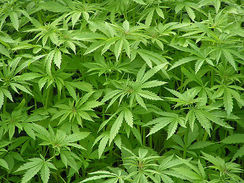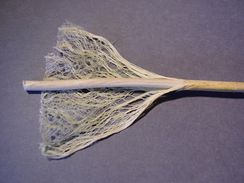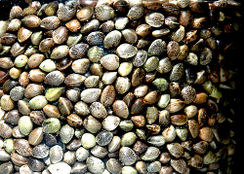Hemp


Hemp has a variety of uses, not just for rope and fabric, but also as a readily renewable resource for making paper, construction materials, high protein food, and safe, clean fuel.
Uses
Hemp can be grown nearly anywhere. It grows very rapidly and has many uses:
- Rope. Hemp fiber is very strong.
- Textiles. Hemp fiber can be woven into a material like light cotton (suitable for T-shirts etc.) or a thick canvas material suitable for bags, warm blankets. See the page on spinning and weaving for instructions on what to do with it once harvested.
- Hempcrete (also see Wikipedia page: hempcrete)
- paper
- a small percentage of hemp was used in what appears to be a composite - rather than bioplastic - car body (70% fiber, of which fiber 10% was hemp, and 30% binder) - [1]
- replacement for plastics (example: hemp fiber, biocomposites, etc.)
- Food - The seeds are extremely nutritious.
- animal feed
- body care (soaps - from hemp oil and lye)
- various chemicals
- fuels (hemp oil / biodiesel/ cellulosic ethanol)
Cultivation, harvest, and processing
Cultivation
Hemp is an annual plant that grows from seed. It is cultivated in a range of soils and in green houses. It can also be grown with Hydroponics.
Beneficial conditions for cultivation in soil
Soil that produces high yields of corn tends to be the most suitable soil for hemp.[2]
The soil must be well drained, rich in nitrogen, and non-acidic.[3]
Soil temperatures must reach a minimum of 42-46°F or 5.5-7.7°C before seeds can be planted.[4]
Hemp prefers a mild climate, humid atmosphere, and a rainfall of at least 25-30 in or 64-76 cm per year.[5]
Harvesting
Harvest timing
The crop is ready for harvesting high quality fiber when the plants begin to shed pollen, in mid-August for North America.[6]
Harvesting for seed occurs four to six weeks later.[7]
Fiber hemp is normally ready to harvest in 70-90 days after seeding.[8]
Equipment for conventional harvesting
Combines are used for harvesting and special machines with rows of independent teeth and a chopper is used for harvesting. To harvest hemp for textiles, specialized cutting equipment is used. [9]
Conventional processing
Retting
After harvest, stalks can be left exposed to the environment for four to six weeks depending on the weather. This is process is called “retting” and removes the pectin [binder]. While the stalks lay in the field, most of the nutrients extracted by the plant are returned to the soil as the leaves decompose. The stalks are turned several times using a special machine for retting evenly.
Baling
After retting, stalks are baled with conventional hay harvesting equipment.
Processing for fiber, hurd, and green micro fiber
A hemp decorticator is a machine that is used to separate the hemp plant in to different materials from which a vast array of products can be made. See main article: Hemp decorticator
Hemp seed processing
A dehulling step, which removes the crunchy skin from the seed using a crushing machine, may be required. Modifications to existing equipment may be required to adequately clean the seeds of hull residues.
Hemp oil extraction
Extraction of oil is normally achieved via mechanical cold pressing; a mechanical expeller press under a nitrogen atmosphere. Solvent extraction methods are also emerging for removing oil since they achieve higher yields. Such methods use hexan, liquid carbon dioxide, or ethanol as the solvent. Refining and deodorizing steps may be required for cosmetics manufacturers.
Storage
The hemp bales are stored in dry places like sheds, barns, or other covered storage. The moisture content of hemp stalks should not exceed 15%.
Hemp seeds must be properly cleaned and dried before storing.
Protection from oxygen, light, and heat is critical for producing tasty oil with an acceptable shelf-life.
Links
- Overview publication - [10]
- North American Industrial Hemp Council
- Appropedia: Hemp
- OMAFRA: Growing Industrial Hemp in Ontario
Industry Standards
- Largest hemp processing plant in America - [11]




